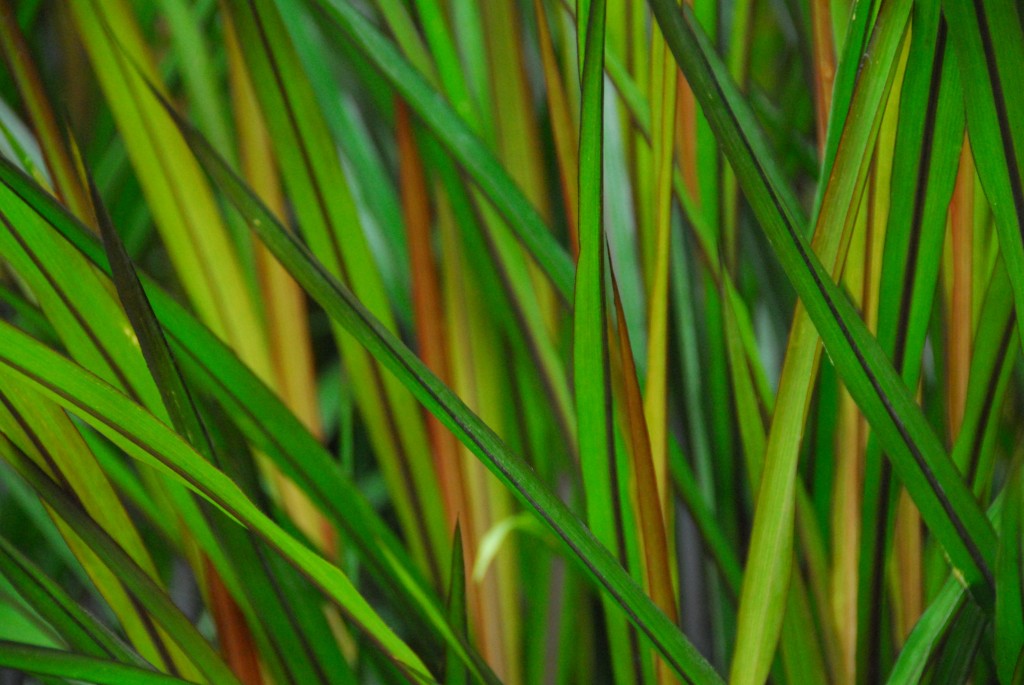I’d clearly been lulled into a false sense of familiarity with the genus Miscanthus. I mean, after lifting and dividing hundreds of them, cutting back possibly millions of individual stems, searching through rows of seedlings in search of minor desirable variations and taking to old clumps with a blunt axe, I thought that I was probably beyond being surprised by them.
Then I spotted Miscanthus sinensis var. condensatus ‘Cosmopolitan’ . The plants were only in 10cm pots, but there was a muscularity about them that captured, and held, the attention.
Variegated miscanthuses have been around for years. But both forms we’ve known are notoriously floppy, demanding support at flowering time. I can’t recall a single instance in which this support was supplied before it was required. Everyone, but everyone, waits until it’s too late. Then they’re forced into an emergency response, which usually involves a single stake and metres of string to achieve a severe trussing that undermines any reason you would have wanted to grow the plant in the first place.
The stout, young stems of this new variegated form promised a whole new story.
I planted in out in mid-spring, then whipped it back out of the ground before it had any chance to take hold, for reasons best explained in an earlier post.
It was (like nearly all potted miscanthus) severely pot-bound, and simply wouldn’t have made it through with the minimal water I had available for the garden. So into a mixed pot it went, with the benefit of daily watering. It doesn’t look like it’ll flower this season, but it has bulked up well, and emanates an irresistible potency.
Its phenomenal stem-strength has dredged up a deep memory of another miscanthus I saw at the Minter Gardens, Canada in 2007. Each of the leaf blades carried both a black midrib, and black edging. The stems were also black, but had a glaucous bloom, making them appear charcoal-grey.
Some of the leaves were starting to show a degree of autumn toning, as so many of the miscanthus do. But what was most impressive was its strength, which bordered on scary. With the quarantine challenges associated with importing grasses, I don’t ever expect to own the thing, but I’d love to know what it was, if anyone’s got any ideas.




Suggest you contact Brian Minters via his website. He is a well respected nurseryman as well as developing Minter Gardens. I’m sure he would be thrilled that you mentioned them in your recent post.
Sandra Ross
Thanks Sandra. I tried that back in 07, but I’ll try again. I’ve got to know what it is..
Damn you Mccoy.
I was just thinking sod the perennials, I’m going to stick with shrubs from now on, when I chanced upon your blog. Been a great read!
Now you’ve got my blood going dreaming of unusual, effervescent combinations and time spent trawling through catalogues and preparing ground and dreaming of the day when….hang on…that wont work…perhaps I should be putting the astrantias in front of the persicaria and then the…….
…it can do your head in.
That black veined miscanthus looks fantastic. Do you know if there is a good zebrinus available in this country yet?
Fair call, Rosco – a damning well deserved. Life would be so much simpler without those pesky, irresistible, impossible, delightful perennials. You’d almost escaped their clutches, then…
Oh, and as for a decent form of Zebrinus – just ran into one today, called Miscanthus ‘Gold Bar’, on the Lambley Nursery stand at the Plant Fair at Flint Hill.
Apparently it’s totally self-supporting, and only of moderate size ie 1.2 ish. Must try it myself.
Lambley’s Zebrinus is good, tough and only flops a tiny little bit. When blown about in stormy, soggy, drenched through conditions – but then who/what wouldn’t?